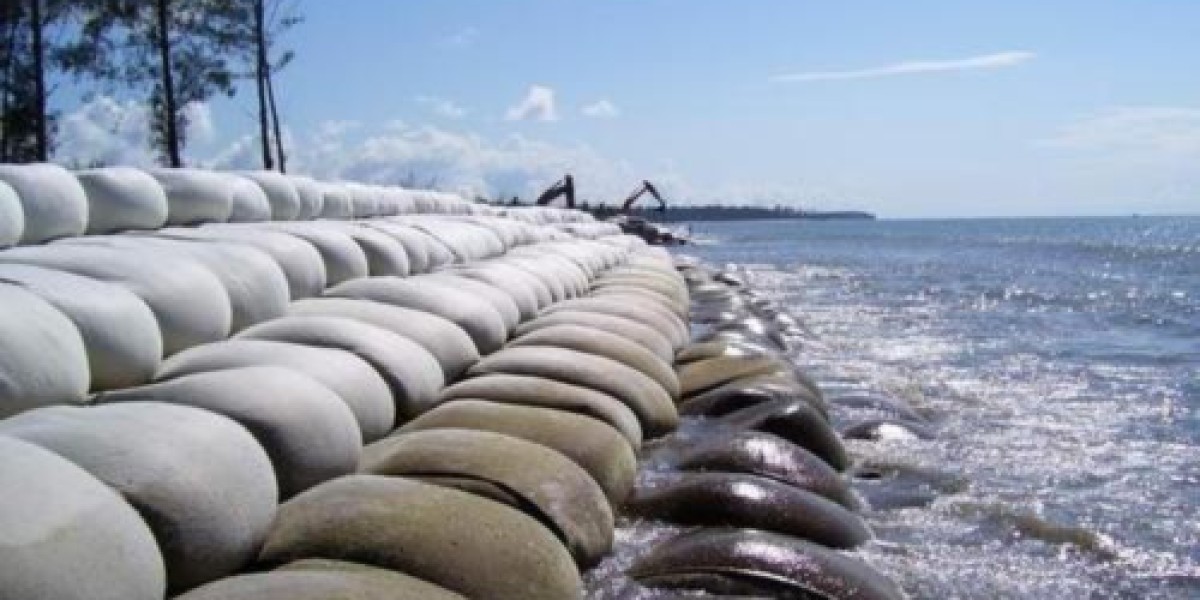Coastal erosion is a growing concern for countries around the world, including India. The relentless action of waves, rising sea levels, and extreme weather events contribute to the gradual loss of valuable coastal land. This erosion not only threatens infrastructure and local communities but also impacts the environment and biodiversity of coastal regions. One of the most effective and sustainable solutions to combat this problem is the use of geotextile bags, commonly known as geo bags. These innovative products have proven to be a strong defense against coastal erosion, offering an eco-friendly and durable approach to shoreline protection.
What Are Geotextile Bags?
Geotextile bags are robust, permeable fabric containers typically made from woven or non-woven polypropylene or polyester materials. These bags are filled with locally available sand or soil and strategically placed along shorelines, riverbanks, and other areas susceptible to erosion. The high-strength material of Geo bags industries in Indias ensures they can withstand harsh environmental conditions, including powerful tidal forces and abrasive elements.
These bags serve as a barrier against the erosive action of water, preventing soil loss and offering stability to the coastline. Unlike traditional concrete or rock-based structures, geotextile bags integrate seamlessly with the natural environment, promoting the growth of vegetation and enhancing the overall ecological balance.
How Geotextile Bags Combat Coastal Erosion
Wave Energy Dissipation: When placed along the coast, geotextile bags absorb and dissipate wave energy, reducing the impact of strong waves on the shore. This minimizes the erosion of soil and sand from the coastline.
Sediment Retention: Geotextile bags help in trapping sediments and promoting natural deposition. This encourages the formation of a stable beach profile and contributes to land reclamation over time.
Preventing Soil Erosion: By acting as a physical barrier, these bags prevent soil from being washed away during high tides or heavy rains, offering long-term stability to coastal structures.
Vegetative Growth Support: The porous nature of the geotextile material allows water to pass through while retaining soil, providing a suitable environment for vegetation to grow. The roots of these plants further stabilize the shoreline, creating a natural and resilient defense against erosion.
Applications of Geotextile Bags
Geotextile bags find application in a wide range of erosion control and coastal protection projects, including:
Coastal and Riverbank Protection: Geo bags are extensively used to safeguard shorelines, riverbanks, and estuaries from erosion. They are especially useful in areas where conventional methods like concrete walls or rock armor are not feasible.
Port and Harbor Construction: During port construction, geotextile bags provide a temporary or permanent barrier against water flow, preventing erosion of underwater soil and promoting stability.
Dune Reconstruction: In regions affected by storms or high tides, geo bags help reconstruct sand dunes, offering a natural buffer against further erosion.
Flood Management: Geotextile bags are also used as flood barriers by filling them with sand and creating temporary levees during emergencies.
Benefits of Using Geotextile Bags
Eco-Friendly Solution: Unlike traditional concrete structures, geo bags blend with the natural environment and support marine and coastal ecosystems.
Cost-Effective: Using locally available fill material, such as sand, reduces transportation costs and makes the installation of geotextile bags economical.
Easy Installation: The installation of geo bags requires minimal equipment and can be carried out quickly, even in remote or challenging environments.
Flexibility and Adaptability: Geotextile bags can be customized in size and shape according to the specific requirements of a project.
Durability and Longevity: High-quality geotextile bags are resistant to UV rays, chemicals, and biological degradation, ensuring long-term performance in harsh conditions.
The Role of Indian Geo Bag Industries
India, with its extensive coastline and numerous river systems, has a growing need for effective erosion control solutions. The Geo bags industries in India have risen to this challenge by offering high-quality products that meet international standards. Leading geo bag manufacturers in India focus on innovation, quality control, and sustainability to provide durable and reliable solutions for coastal and riverbank protection projects.
In addition, India has emerged as a significant player in the global market, with Geo bag exporters in Ahmedabad contributing to international projects in regions facing similar erosion challenges. The expertise and experience of Indian manufacturers ensure that the products delivered are not only robust but also tailored to meet the specific needs of different environments.
Future of Geotextile Bags in Coastal Management
As climate change continues to impact coastal areas worldwide, the demand for sustainable erosion control solutions like geotextile bags is expected to grow. Researchers and engineers are continually working to improve the material properties and design of geo bags, enhancing their effectiveness and broadening their applications.
Future innovations may include the use of biodegradable materials, smart sensors to monitor structural integrity, and advanced manufacturing techniques to increase the strength and durability of geotextile bags.
Governments and environmental agencies are also recognizing the benefits of using geo bags in their coastal management strategies. By investing in this technology, they can protect valuable land, safeguard communities, and promote ecological balance along coastlines.
Conclusion
Geotextile bags have proven to be a strong and sustainable defense against coastal erosion. Their ability to absorb wave energy, retain sediment, and support vegetative growth makes them an ideal choice for coastal protection projects. With Geo bag manufacturers in India playing a pivotal role in manufacturing and exporting high-quality geo bags, the country is contributing significantly to global efforts in erosion control and shoreline stabilization.
As we continue to face environmental challenges, adopting innovative and eco-friendly solutions like geotextile bags will be crucial in preserving our coastal regions for future generations.
Frequently Asked Questions (FAQs)
What are geotextile bags made of, and how do they work against erosion?
Geotextile bags are made from high-strength woven or non-woven polypropylene or polyester fabrics. When filled with sand or soil, these bags act as a barrier against wave action, preventing soil erosion and promoting sediment accumulation along shorelines and riverbanks.Can geotextile bags be used in both freshwater and marine environments?
Yes, geotextile bags are versatile and can be used in both freshwater and marine environments. They are resistant to UV rays, chemicals, and biological degradation, making them suitable for a variety of erosion control and coastal management applications.How long do geotextile bags last in coastal protection projects?
The durability of geotextile bags depends on the material quality and environmental conditions. High-quality geo bags can last several years, even in harsh conditions, offering a reliable and long-term solution for erosion control.








